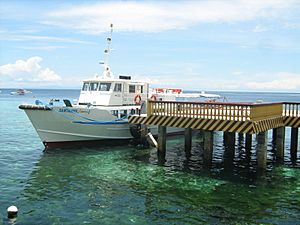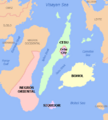Central Visayas facts for kids
Quick facts for kids Central Visayas (Gitnang Kabisayaan) |
|
| Region VII | |
| Region | |
| Country | Philippines |
|---|---|
| Island group | Visayas |
| Provinces | Bohol, Cebu, Negros Oriental, Siquijor |
| Regional center | Cebu City |
| Area | 15,875 km² (6,129 sq mi) |
| Population | 6,800,180 (2010) |
| Density | 428 /km² (1,109 /sq mi) |
| Timezone | PST (UTC+8) |
Central Visayas, also known as Region VII, is a special area in the central part of the Visayas islands in the Philippines. It has four provinces: Bohol, Cebu, Negros Oriental, and Siquijor. The region also includes three big, independent cities: Cebu City, Lapu-Lapu City, and Mandaue.
Most people in Central Visayas speak Cebuano. The main city and center of the region is Cebu City. The total land area of Central Visayas is about 15,875 square kilometers. In 2010, about 6.8 million people lived here, making it one of the most populated regions in the Philippines.
Contents
Provinces and Main Cities
Central Visayas is made up of four provinces and three independent cities. These independent cities manage themselves and are not part of any province, even if they are located within one.
| Province/City | Capital | Population (2010) |
Area (km²) |
|---|---|---|---|
| Bohol | Tagbilaran City | 1,255,128 | 4,117.3 |
| Cebu | Cebu City | 2,619,362 | 4,800.11 |
| Negros Oriental | Dumaguete City | 1,286,666 | 5,402.3 |
| Siquijor | Siquijor | 91,066 | 343.5 |
| Cebu City | – | 866,171 | 280.2 |
| Lapu-Lapu City | – | 350,467 | 64.22 |
| Mandaue | – | 331,320 | 34.87 |
Other Important Cities
Besides the main cities listed above, Central Visayas also has several other important cities:
- Bais City, Negros Oriental
- Bayawan City, Negros Oriental
- Canlaon City, Negros Oriental
- Dumaguete City, Negros Oriental
- Tanjay City, Negros Oriental
- Danao City, Cebu
- Talisay City, Cebu
- Toledo City, Cebu
- Tagbilaran City, Bohol
Weather in Central Visayas
Central Visayas usually has cloudy skies and some rain. It is surrounded by another region, Eastern Visayas, which helps protect it from many strong typhoons. The air is often humid, meaning it feels moist, with humidity levels between 80-90%. The dry season is usually in April and May, while the rest of the year tends to be wet.
People and Languages
In 2010, about 6.8 million people lived in Central Visayas. The population grew by about 1.59% each year between 2000 and 2007.
The main language spoken in the region is Cebuano. In Bohol, people call their version of Cebuano "Boholano." On the Camotes Islands in Cebu, Cebuano is spoken in most towns. However, in the town of Poro, people speak a unique language called Porohanon. This language is a mix of Cebuano, Hiligaynon, and Masbateño.
Getting Around: Transportation
Traveling by Sea
The Port of Cebu is the busiest port in the region. It is like the main door for ships coming in and out. There are also important ports in Dumaguete City (Negros Oriental), Tagbilaran (Bohol), and Larena (Siquijor). Many shipping companies offer trips between these islands, including fastcrafts that get you there quickly.
Traveling by Air
The Mactan-Cebu International Airport, located in Lapu-Lapu City, is the second busiest airport in the Philippines. It is the only airport in the Visayas that has international flights to other countries in Asia. Major airlines like Cebu Pacific and Philippine Airlines use this airport as a main base for flights to cities all over the country.
Other airports in the region include Sibulan Airport near Dumaguete City, which has flights to Manila and Cebu. There is also Tagbilaran Airport in Bohol, offering flights to Manila.
Images for kids
See also
 In Spanish: Bisayas Centrales para niños
In Spanish: Bisayas Centrales para niños





